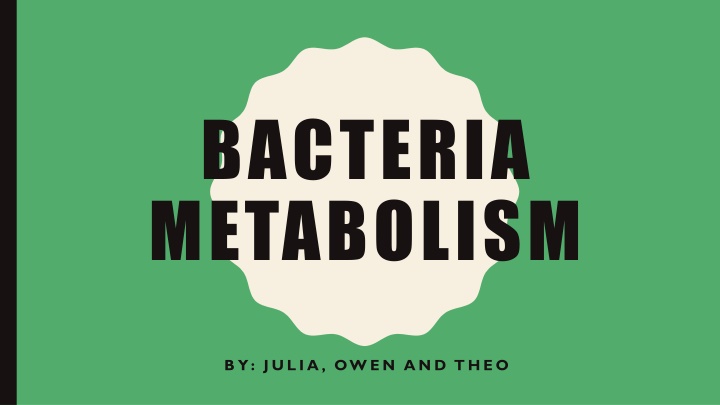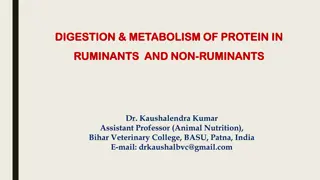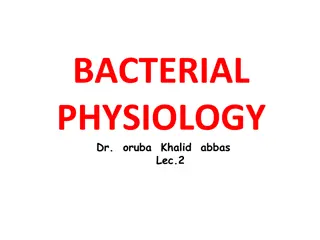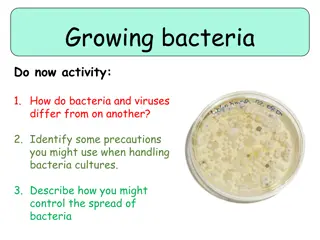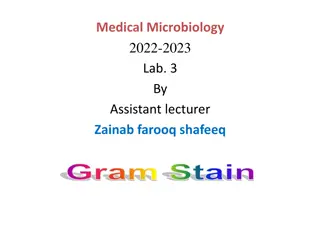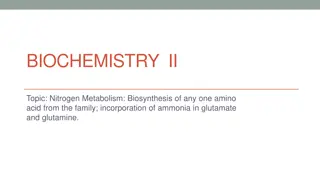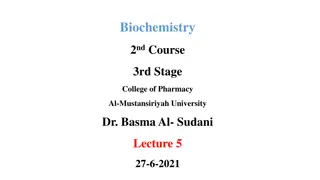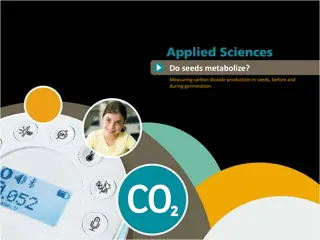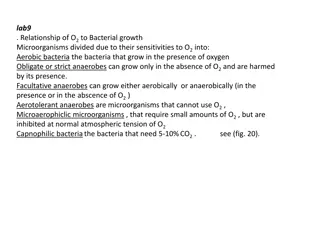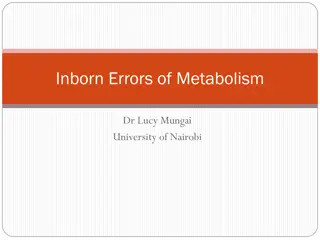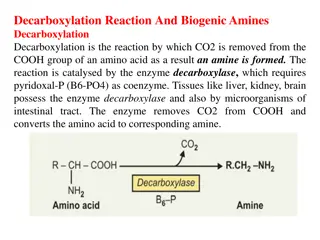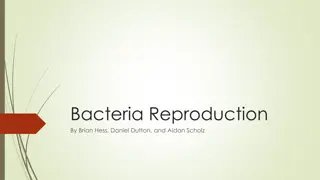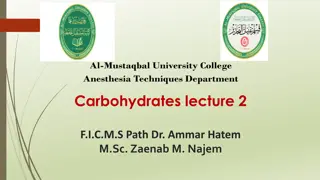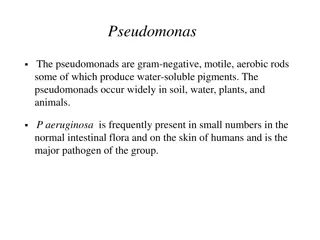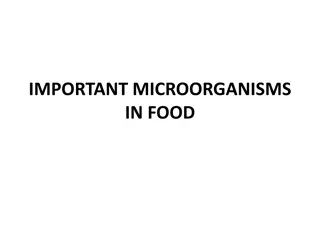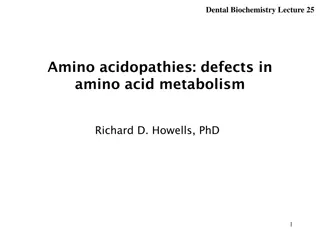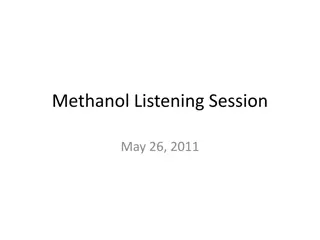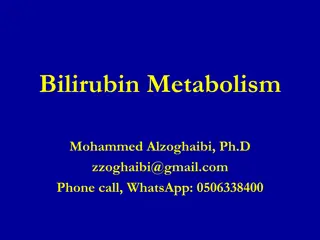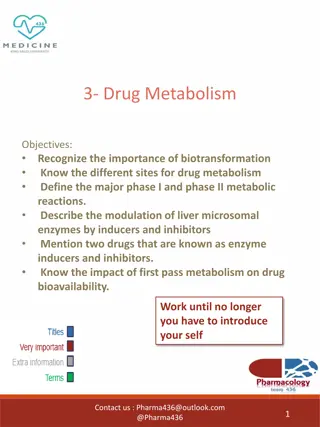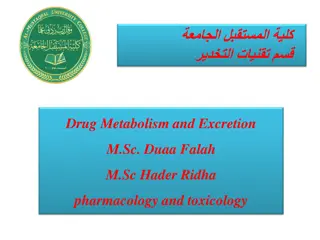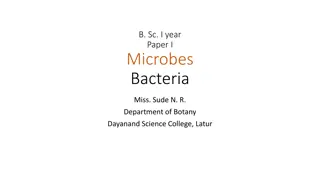BACTERIA METABOLISM
In this detailed overview, explore how different types of prokaryotic and eukaryotic cells obtain and release energy through processes like photosynthesis, cellular respiration, glycolysis, and fermentation. Learn about the unique ways bacteria cells use light energy, chemical energy, and inorganic compounds to fuel their activities. Discover the role of autotrophs, heterotrophs, and various metabolic pathways in energy production. Gain insights into the modes of metabolism and environmental conditions affecting energy release in prokaryotic cells.
Download Presentation

Please find below an Image/Link to download the presentation.
The content on the website is provided AS IS for your information and personal use only. It may not be sold, licensed, or shared on other websites without obtaining consent from the author.If you encounter any issues during the download, it is possible that the publisher has removed the file from their server.
You are allowed to download the files provided on this website for personal or commercial use, subject to the condition that they are used lawfully. All files are the property of their respective owners.
The content on the website is provided AS IS for your information and personal use only. It may not be sold, licensed, or shared on other websites without obtaining consent from the author.
E N D
Presentation Transcript
BACTERIA METABOLISM BY: JULIA, OWEN AND THEO
OVERVIEW Different cells and how they obtain energy Photosynthesis and Cellular Respiration How cells release energy
HOW DIFFERENT TYPES OF PROKARYOTIC CELLS OBTAIN ENERGY (PARTNER 1) Occurs in bacteria cells Autotrophs=prokaryotes use light (photoautotrophic) energy and chemical (chemoautotrophic) energy Photoautotrophs: have chlorophyll (found in vesicles), used for photosynthesis Conversion of H2O + CO2 C6H12O6 (glucose) + O2 Chemoautotrophs: use chemosynthesis, break down inorganic compounds Found in deep sea vents, using CO2 as carbon source
HOW DIFFERENT TYPES OF PROKARYOTIC CELLS OBTAIN ENERGY (PARTNER 1) Heterotrophs=use other organisms for organic compounds Photoheterotrophs: light energy chemical energy, gets CO2 from other organism/carbon source Chemoautotrophs: do not have mitochondria, use enzymes attached to cell-membrane organic compounds ATP (thermal energy) Prokaryotes use plasma membrane as energy collector
HOW DIFFERENT EUKARYOTIC CELLS OBTAIN ENERGY (PARTNER 1) Occurs in Plant and Animal cells Aerobic Respiration=cells need oxygen (O2) to obtain energy (ATP) Plant cells: photosynthesis performed in chloroplast (thylakoid & stroma) produces glucose Mitochondria converts glucose ATP through oxidative metabolism
HOW DIFFERENT EUKARYOTIC CELLS OBTAIN ENERGY (PARTNER 1) Glycolysis= sugar splitting breaks down glucose 2 pyruvate molecules 2 NADPH+ molecules Citric Acid Cycle FADH2 Fermentation=takes place in cytoplasm, doesn t need oxygen Cellular Respiration creates total of 38 ATP
HOW DO PROKARYOTIC CELLS RELEASE ENERGY? (PARTNER 2) Chemical energy stored in fuel molecules (ex. Sugar) Various ways to release energy Modes of Metabolism= Obligate aerobe, Obligate anaerobe, Facultative anaerobe Condition of environment= method of release
MODE OF METABOLISM (PARTNER 2) Require to release prokaryotic energy ObligateAerobe= requires oxygen to release energy, (ex. Mycobacterium tuberculosis: found in human lungs) Obligate Anaerobe= requires lack of oxygen to release energy, (ex. Clostridium botulinum: improperly sterilized canned food causes food poisoning) Facultative Anaerobe= with or without energy to release (ex. E. coli: sewage (oxygen) and human intestine (oxygen)
EUKARYOTIC CELLS CONVERT CHEMICAL ENERGY INTO ATP (PARTNER 2) Convert energy from one form to another Mitochondria converts chemical to ATP on eukaryotic cells Cellular Respiration occurs in mitochondria during Krebs Cycle ATP is used as a battery, used all around the cell
RELATION BETWEEN PHOTOSYNTHESIS AND CELLULAR RESPIRATION Photosynthesis produces glucose used in cellular respiration Glucose is turned back into carbon dioxide, gets reused in photosynthesis Without oxygen produced by photosynthesis much less ATP would be produced
MITOCHONDRIA VS. CHLOROPLASTS Similar Convert energy Double membrane Differences Chloroplast only found in plant cells Chloroplast produce glucose, mitochondria produce ATP Mitochondria are in cellular respiration, chloroplast are in photosynthesis Mitochondria have 2 compartments (crista and matrix) chloroplast have 3 (Thylakoid, granum and stroma) oxygen (O2) and carbon dioxide (CO2) involved in both processes Have their own DNA within the cell
FERMENTATION Process in order to replenish NAD+ NAD+ is reused in glycolysis Used in absence of oxygen; occurs in cytoplasm Alcoholic vs. Lactic Acid
FERMENTATION (PT. 2) Alcoholic: plant and bacteria cells Lactic Acid: animal and bacteria cells Alcoholic fermentation causes yeast (fungus) to rise Overworked muscles produce lactic acid (muscle cramps)
PARTNER 1S ABCS What type of prokaryote obtains energy through sunlight? A)Chemoautotrophs B) Photoheterotrophs C)Photoautotrophs D)Both B and C
PARTNER 1 ABCS Eukaryotic cells need to produce what before energy? A) ATP B) CHO C) Glucose D) Oxygen
PARTNER 2 ABCS What mode of metabolism requires oxygen to release energy? A. Obligate aerobe B. Isotonic C. Facultative Anaerobe D. Obligate Anaerobe
PARTNER 2 ABCS In what specific location is the cite of cellular respiration? A. Stroma B. Mitochondria C. Chloroplast D. Cytoplasm
PARTNER 3 ABCS What is a similarity between mitochondria and chloroplasts? A. Have their own DNA B. Double membrane C. Produce glucose D. Both A and B
PARTNER 3 ABCS Where does fermentation occur? A. Mitochondria B. Cytoplasm C. Rough ER D. Vacuole
OVERVIEW Photosynthesis and Cellular Respiration How cells obtain energy How cells release energy
